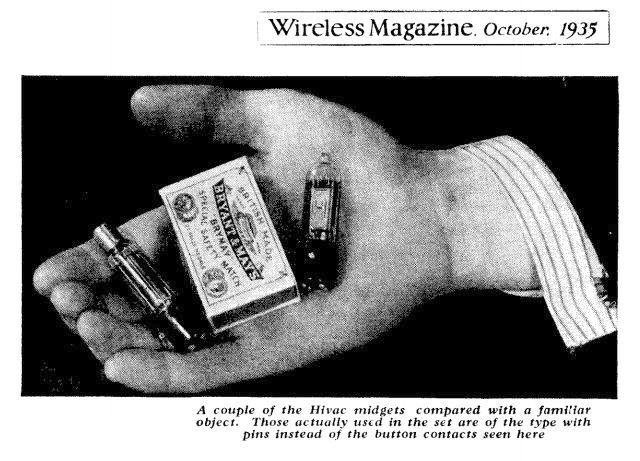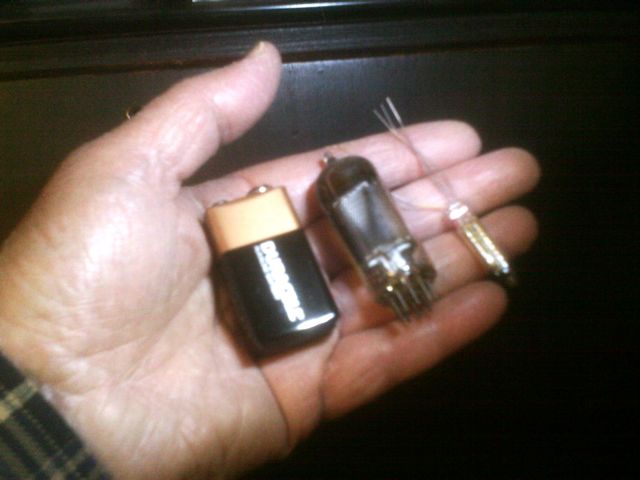Sunday, October 15, 2017
Earlier than thought
I've been piddling around with submini tubes for a while. Credit for their invention goes to American tubemakers like Raytheon, who developed the size for onboard navigation and fusing in missiles and torpedos. Subminis became popular after the war in hearing aids and portable radios. Their reign was brief because transistors took over both duties around 1957. Russians continued using the subminis MUCH longer. Sputnik used subminis in its transmitter. Most of the NOS subminis on the market now are Russian, made in the '60s and '70s.
As usual the credit is wrong, and as usual in electronics the Brits got there first. An article in Practical Wireless in Oct 1935 shows a portable receiver built with subminis.
The British version may have been slightly larger than the WW2 Raytheon version. For dubious comparison, here's a picture from the 10/35 mag:
 And here's my hand with a similarly familiar object and two of the postwar Raytheon subminis.
And here's my hand with a similarly familiar object and two of the postwar Raytheon subminis.
 Best comparison is on the fingers. The Brit tube, leaving off the plugs, appears to span 1.8 fingers, while the Raytheon spans about 1.5 fingers. The Brit hand has fatter fingers than my hand, so the difference may be slightly greater.
In any case, these Brit tubes are NOT the 7-pin minis that were far more common in radios and TVs. The 7-pin covers about 2.8 of my fingers.
Best comparison is on the fingers. The Brit tube, leaving off the plugs, appears to span 1.8 fingers, while the Raytheon spans about 1.5 fingers. The Brit hand has fatter fingers than my hand, so the difference may be slightly greater.
In any case, these Brit tubes are NOT the 7-pin minis that were far more common in radios and TVs. The 7-pin covers about 2.8 of my fingers.
 The Brit Hivac tubes are in between the sizes, but closer to the Raytheon submini.
The Brit Hivac tubes are in between the sizes, but closer to the Raytheon submini.
 And here's my hand with a similarly familiar object and two of the postwar Raytheon subminis.
And here's my hand with a similarly familiar object and two of the postwar Raytheon subminis.
 Best comparison is on the fingers. The Brit tube, leaving off the plugs, appears to span 1.8 fingers, while the Raytheon spans about 1.5 fingers. The Brit hand has fatter fingers than my hand, so the difference may be slightly greater.
In any case, these Brit tubes are NOT the 7-pin minis that were far more common in radios and TVs. The 7-pin covers about 2.8 of my fingers.
Best comparison is on the fingers. The Brit tube, leaving off the plugs, appears to span 1.8 fingers, while the Raytheon spans about 1.5 fingers. The Brit hand has fatter fingers than my hand, so the difference may be slightly greater.
In any case, these Brit tubes are NOT the 7-pin minis that were far more common in radios and TVs. The 7-pin covers about 2.8 of my fingers.
 The Brit Hivac tubes are in between the sizes, but closer to the Raytheon submini.
The Brit Hivac tubes are in between the sizes, but closer to the Raytheon submini.Labels: Alternate universe
